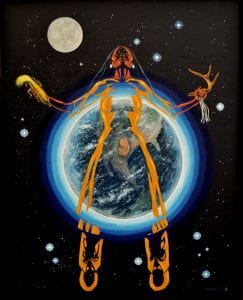Iroquois League of Five Nations
Oral tradition: c. 1100-1450 CE
Transcribed on wampum belt: c. 1624
Earliest publication (Mohawk Version): 1883
The Great Law of Peace
(Kaianerekowa)
The struggle to form a unifying law by the formerly strife-torn Iroquois nations is, by all measures, an epic account full of stories that defy ordinary reality. No doubt, as with many founding myths, actual events have been embellished over time. The Peacemaker, for example, sometimes travels in a stone canoe.
The evil Onondaga wizard Tadadaho, the main opponent of the new law, is so overpoweringly ugly that he has snakes for hair and a penis that can’t be described in a book meant for anyone below the age of adult consent. After a long battle, Tadadaho comes to accept the Great Law of Peace, as his name becomes the title of its chief executive (speaker), at the central council fire (Onondaga).
According to the Iroquois’ traditional account, the idea of a federal union was introduced through Deganwidah, a Huron who lived in what is now eastern Ontario. Deganwidah was unsuited himself to propose the idea not only because of his non-Iroquoian ancestry, but also because he stuttered so badly that he could scarcely talk. He would have had the utmost difficulty in presenting his idea to societies where oratory was prized. And writing, aside from the pictographs of the wampum belts, was not used.
Deganwidah, wandering from tribe to tribe trying to figure ways to realize his dream of ending war among them all, met Hiawatha, who agreed to speak for him. Hiawatha (a man far removed from Longfellow’s poetic creation) undertook long negotiations with leaders of the warring Indian nations and, in the end, produced a peace along the lines of Deganwidah’s vision. This peace was procured, and maintained, through the constitution of the league, the Great Law of Peace (untranslated: Kaianerekowa). [….]
The Great Law of Peace was not written in English until about 1880 when Seth Newhouse, a Mohawk, transcribed it. By this time, many of the traditional sachems of the league, worried that the wampum belts that contained the Great Law’s provisions might be lost or stolen, sought a version written in English. One such translation was compiled by Arthur C. Parker. In recent years, the text of the Great Law has been published in several editions by Akwesasne Notes, a journal for “native and natural peoples” published on the Mohawk Nation. The substance of all these written translations is similar, although wording varies at some points.
The text of the Great Law begins with the planting of the Tree of the Great Peace; the great white pine — from its roots to its spreading branches — serves throughout the document as a metaphor for the unity of the league. The tree, and the principal council fire of the confederacy, were located on land of the Onondaga Nation, at the center of the confederacy, the present site of Syracuse, New York.
Bruce E. Johansen
University of Nebraska at Omaha (emeritus)
Paragraphs 2-5 excerpted from “The Pre-Columbian Republic,” Chapter 2 of Forgotten Founders: How the Iroquois Helped Shape Democracy [1982] (Boston: Harvard Common Press, 1987).
Resources
EDITIONS:
Woodbury, Hanni, comp. Concerning the League: The Iroquois League Tradition as Dictated in Onondaga by John Arthur Gibson, comp. Hanni Woodbury, Reg Henry, and Harry Webster on the basis of A. A. Goldenweiser’s manuscript. Algonquian and Iroquoian Linguistics, Memoir No. 9. Winnipeg, Manitoba: University of Manitoba Press, 1992.
FURTHER READING:
Brown, Judith K. “Economic Organization and the Position of Women among the Iroquois.” Ethnohistory 17:3/4 (Summer/Fall 1970):151-167.
Colden, Cadwallader. The History of the Five Nations Depending on the Province of New York in America [1727, 1747]. Ithaca, N.Y.: Cornell University Press, 1958.
Crevecouer, Hector Saint John de. Journey into Northern Pennsylvania and the State of New York [1801, in French]. Ann Arbor: University of Michigan Press, 1964.
Fenton, William N. “Seth Newhouse’s [Dayodekane’s] Traditional History and Constitution of the Iroquois Confederacy.” Proceedings of the American Philosophical Society 93:2(1949): 141-158.
Fenton, William N. The Great Law and the Longhouse: A Political History of the Iroquois Confederacy. Norman: University of Oklahoma Press, 1998.
Franklin, Benjamin. The Autobiography of Benjamin Franklin, ed. John Bigelow. Philadelphia: J. B. Lippincott, 1868.
Gage, Matilda Joslyn. Woman, Church and State, [1893]. Watertown, MA: Peresphone Press, 1980.
Grinde, Donald A., Jr., and Bruce E. Johansen. Exemplar of Liberty: Native America and the Evolution of Democracy. Los Angeles: UCLA American Indian Studies Center, 1991.
Hewitt, J[ohn] N[apoleon] B[rinton]. “Some Esoteric Aspects of the League of the Iroquois.” Proceedings of the International Congress of Americanists 19 (1915): 322-326.
Hewitt, J[ohn] N[apoleon] B[rinton]. “A Constitutional League of Peace in the Stone Age of America: The League of the Iroquois and Its Constitution.” Smithsonian Institution Series (1920): 527-545.
Jacobs, Renée. “Iroquois Great Law of Peace and the United States Constitution: How the Founding Fathers Ignored the Clan Mothers.” American Indian Law Review 16:2(1991):497-531.
Jemison, Pete. “Mother of Nations—-The Peace Queen, A Neglected Tradition.” Akwe:kon (1988): 68-70.
Johansen, Bruce E. Forgotten Founders. Benjamin Franklin, the Iroquois and the Rationale for the American Revolution [1982]. Boston: Harvard Common Press, 1987.
Labaree, Leonard W., ed. The Papers of Benjamin Franklin. New Haven: Yale University Press, 1950 to present. Volume 4.
Mann, Barbara A. and Jerry L. Fields. “A Sign in the Sky: Dating the League of the Haudenosaunee.” American Indian Culture and Research Journal 21:2(1997): 105-163.
Mann, Barbara A. “The Lynx in Time: Haudenosaunee Women’s Traditions and History.” American Indian Quarterly. 21:3(1997):423-450.
Mann, Barbara A. “Haudenosaunee (Iroquois) Women, Legal and Political Status.” The Encyclopedia of Native American Legal Tradition. Ed. Bruce Elliott Johansen. Westport, CT: Greenwood Press, 1998: 112-131.
Mann, Barbara A. Iroquoian Women: Gantowisas of the Haudenosaunee League. New York: Peter Lang Publishers, 2000.
Morgan, Lewis Henry. League of the Haudenosaunee, or Iroquois. 1851. 2 vols. New York: Burt Franklin, 1901.
O’Callaghan, Edmund Bailey, ed., Documents Relative to the Colonial History of New York (Albany: Weed, Parsons, 1853-1887). Vols. 4,6.
Parker, Arthur C. The Constitution of the Five Nations, or The Iroquois Book of the Great Law. Albany: The University of the State of New York, 1916.
Parker, Arthur C. The White Roots of Peace. Empire State Historical Publication Series No. 56. Port Washington, Long Island, NY: Ira J. Friedman, Inc., 1946.
Smyth, Albert H., ed., The Writings of Benjamin Franklin. New York: MacMillan Co., 1905-1907. Volume 3.
Thomas, Chief Jacob [Cayuga], with Terry Boyle. Teachings from the Longhouse. Toronto: Stoddart Publishing Co., Ltd., 1994.
Tooker, Elisabeth. “The League of the Iroquois: Its History, Politics, and Ritual.” Handbook of North American Indians, Northeast (Vol. 15) Washington, D.C.: Smithsonian Institution, 1978, 418-441.
Tooker, Elisabeth, ed. Native North American Spirituality of the Eastern Woodlands: Sacred Myths, Dreams, Visions, Speeches, Healing Formulas, Rituals and Ceremonials. New York: Paulist Press, 1979.
Van Doren, Carl and Julian P. Boyd, eds. Indian Treaties Printed by Benjamin Franklin 1736-1762. Philadelphia: Historical Society of Pennsylvania, 1938.
Venables, Robert W. “The Founding Fathers: Choosing to be Romans.” Northeast Indian Quarterly 6:4 (Winter, 1989):30-35.
Wagner, Sally Roesch. “The Iroquois Confederacy: A Native American Model for Non-sexist Men,” Changing Men, (Spring-Summer, 1988,32-33.
Wagner, Sally Roesch The Untold Story of the Iroquois Influence on Early Feminists. Aberdeen, S.D.: Sky Carrier Press, 1996.
Wallace, Paul A. W. The White Roots of Peace. Philadelphia: University of Pennsylvania Press, 1946.
Waugh, F.W. Iroquois Foods and Preparation [1916]. Ottawa: National Museum of Canada, 1973.
White Roots of Peace. The Great Law of the Longhouse People. Rooseveltown: Akwesasne Notes, 1977.
Wilson, Edmund. Apologies to the Iroquois. New York: Vintage Books, 1960.
The above bibliography was compiled by Bruce E. Johansen (University of Nebraska at Omaha).

